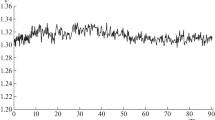Summary
Cytochromec added during the formation of lecithin-cardiolipin liquid crystals in 0.015m KCl is readily bound. After successive washings with 0.15m KCl, only about 50% of this bound cytochromec is removed. The remaining cytochromec is resistant to further salt extraction, and the amount of this cytochromec that is bound varies with the concentration of added cytochromec to a maximum binding ratio of 1∶70, mole ratio cytochromec to phospholipid. This binding appears to be electrostatic; it is competitively inhibited by increasing the initial molarity of KCl from 0.015 to 0.10m. Binding of cytochromec is insignificant in the absence of cardiolipin, and is affected by varying the pH. Electron microscope studies of osmium tetroxide-stained thin sections show that the liquid crystals consist of vesicles, each of which contains a large number of concentric, alternating light and dense lines. The dense lines have been identified by other workers with the polar head groups of the phospholipids on the surface of a bilayer, and the light area represents the hydrophobic interior. The addition of cytochromec causes an average decrease in the number of lines per vesicle. It increases the center-to-center distance between two neighboring light or dense lines and the width of the dense lines. On the basis of this evidence and electrostatic binding, it is concluded that cytochromec is binding on the polar surfaces of the phospholipid bilayers comprising the liquid crystalline vesicles.
Similar content being viewed by others
References
Bangham, A. D. 1968. Membrane models with phospholipids.In: Progress in Biophysics and Molecular Biology. J. A. V. Butler and D. Noble, editors. p. 18. Pergamon Press, New York.
—, Standish, M. M., Watkins, J. C. 1965. Diffusion of univalent ions across the lamellae of swollen phospholipids.J. Mol. Biol. 13:238.
Bartlett, G. R. 1959. Phosphorus assay in column chromatography.J. Biol. Chem. 234:466.
Das, M. L., Crane, F. L. 1964. Proteolipids. I. The formation of phospholipid-cytochromec complexes.Biochemistry 3:696.
—, Haak, E. D., Crane, F. L. 1965. Proteolipids. IV. Formation of complexes between cytochromec and purified phospholipids.Biochemistry 4:859.
Dickerson, R. E., Kopka, M. L., Borders, C. I., Varnum, J., Weinzierl, J. E., Margoliash, E. 1967. A centrosymmetric projection at 4 Å of horse heart oxidized cytochromec.J. Mol. Biol. 29:77.
Gorter, E., Grendel, F. 1925. On bimolecular layers of lipoids on the chromocytes of the blood.J. Exp. Med. 41:439.
Green, D. E., Fleischer, S., 1963. The role of lipids in mitochondrial electron transfer and oxidative phosphorylation.Biochim. Biophys. Acta 70:554.
Gulik-Krzywicki, T., Schechter, E., Luzzati, V., Faure, M. 1969. Interactions of proteins and lipids: Structure and polymorphism of protein-lipid-water phases.Nature 223:1116.
Jacobs, E. E., Sanadi, D. R. 1960. The reversible removal of cytochromec from mitochondria.J. Biol. Chem. 235:531.
Kimelberg, H. K., Lee, C. P. 1969. Binding and electron transfer to cytochromec in artificial phospholipid membranes.Biochem. Biophys. Res. Commun. 34:784.
—— 1970. Interactions of cytochromec with phospholipid membranes. II. Reactivity of cytochromec bound to phospholipid liquid crystals.J. Membrane Biol. 2:252.
Lee, C. P., Carlson, K. 1968. Binding of cytochromec to fragmented mitochondrial membranes.Fed. Proc. 27:828.
Lee, C. P., Ernster, L. 1966. Energy-linked pyridine nucleotide transhydrogenase: Its characteristics and its use as a tool for the study of oxidative phosphorylation.In: Regulation of Metabolic Processes in Mitochondria. J. M. Tager, S. Papa, E. Quagliariello and E. C. Slater, editors. BBA Library.7:218.
Lenaz, G., MacLennan, D. H. 1966. Studies on the mechanism of oxidative phosphorylation. X. The effect of cytochromec on energy-linked processes in submitochondrial particles.J. Biol. Chem. 241:5260.
Luft, J. H. 1961. Improvements in epoxy resin embedding methods.J. Biophys. Biochem. Cytol. 9:409.
Machinist, J. M., Das, M. L., Crane, F. L., Jacobs, E. E. 1961. A negatively charged pore in the mitochondrial membrane as a site for cytochromec function.Biochem. Biophys. Res. Commun. 6:475.
Margoliash, E., Frohwirt, N. 1959. Spectrum of horse heart cytochromec.Biochem. J. 71:570.
Nicholls, P., Mochan, E., Kimelberg, H. K. 1969. Complex formation by cytochromec: A clue to the structure and polarity of the inner mitochondrial membrane.Fed. Europ. Biochem. Socs. Letters 3:242.
Papahadjopoulos, D. 1968. Surface properties of acidic phospholipids: Interaction of monolayers and hydrated liquid crystals with uni- and bivalent metal ions.Biochim. Biophys. Acta 163:240.
— Miller, N. 1967. Phospholipid model membranes I. Structural characteristics of hydrated liquid crystals.Biochim. Biophys. Acta 135:624.
Parsons, D. F., Williams, G., Thompson, W., Wilson, D., Chance, B., 1967. Improvements in the procedure for purification of mitochondrial outer and inner membrane. Comparison of the outer membrane with smooth endoplasmic reticulum.In: Mitochondrial Structure and Function. J. M. Tager, S. Papa, E. Quagliariello, and E. C. Slater, editors. p. 29. Adriatica Editrice, Bari.
Reich, M., Wainio, W. W. 1961. A cytochromec-phospholipid complex.J. Biol. Chem. 236:3058.
Reynolds, E. S. 1963. The use of lead citrate at high pH as an electron-opaque stain in electron microscopy.J. Cell Biol. 17:208.
Schneider, W. C., Claude, A., Hogeboom, G. H. 1948. The distribution of cytochromec and succinoxidase activity in rat liver fractions.J. Biol. Chem. 172:451.
Shah, D. S., Schulman, J. H. 1965. Binding of metal ions to monolayers of lecithins, plasmolagen, cardiolipin, and dicetyl phosphate.J. Lipid Res. 6:341.
Shipley, G. G., Leslie, R. B., Chapman, D. 1969a. Small-angle X-ray scattering studies of cytochromec-phospholipid complexes.Biochim. Biophys. Acta 173:1.
——— 1969b. X-ray diffraction study of the interaction of phospholipids with cytochromec in the aqueous phase.Nature 222:561.
Stoeckenius, W., Schulman, J. H., Prince, L. M. 1960. The structure of myelin figures and microemulsions as observed with the electron microscope.Kolloidzschr. 169:170.
Theorell, W., Åkesson, A. 1941. Studies on cytochromec. II. The optical properties of pure cytochromec and some of its derivatives.J. Amer. Chem. Soc. 63:1804.
Tsou, C. L. 1952. Exogenous and endogenous cytochromec.Biochem. J. 50:493.
Author information
Authors and Affiliations
Rights and permissions
About this article
Cite this article
Kimelberg, H.K., Lee, C.P., Claude, A. et al. Interactions of cytochromec with phospholipid membranes. J. Membrain Biol. 2, 235–251 (1970). https://doi.org/10.1007/BF01869862
Received:
Issue Date:
DOI: https://doi.org/10.1007/BF01869862




